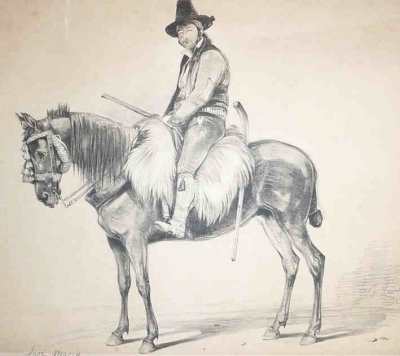El Tempranillo: The King of the Sierra Morena
All countries have their scallywags, men and women who prefer to live outside the law. They exist on their wits in a hostile and lonely environment, not unlike marriage perhaps but still a desperate place. The outlaws' life has brought fame to some, infamy to others but very short careers usually with a bloody end to most.
by John McDonald
Terrorising the prairie towns of the Wild West was Jesse James and others of his ilk. Making a nuisance of himself in the antipodes was the metal clad Ned Kelly. With very few exceptions they were bully-boys thugs and murderers, yet they became idolised by later generations. Their crimes whitewashed and their limited humanity elevated. Some are composite outlaws with the deeds of others attributed to them. Dick Turpin never made the famous ride to York. It was John Nevison, alias Swift Nick half a century earlier. At least two anonymous individuals compose the character of Robin Hood. Considering the brutality and uncertainty of the age labelling his men as Merry is extremely questionable. Mr Hood’s rather strange fiscal policy of taking from the rich and giving to the poor is also questionable. It was nothing more than bribes granted to secure his base of operations.

El Tempranillo Photo www.galeon.com
Bandits can only operate where conditions allow. There must be a certain amount of law and order to enable the movement of people and goods. Hordes of baddies moving through the countryside are synonymous with a developing nation. When national organisation is such as to restrict their activities, daylight robbery becomes the task of gas, electric and banking concerns.
Spain has had its share of rapscallions operating in all of its regions. In the nineteenth century, Andalucían brigandage was an attraction for early tourists. These travellers purposely fell into the hands of the many bands of bandoleros. British and other Europeans were known to pay for the privilege of such an encounter. One can imagine the heroic stories told over roaring fires on cold winter nights. In any event it was probably safer than a 'Club 18 to 30' bargain weekend.
Arguably the most famous Andalucían bandolero was José Maria Hinojosa Cabacho. Known as El Tempranillo, this epithet probably refers to his early entry into banditry at the age of thirteen.
El Tempranillo had all the characteristics necessary for local hero status. The first perquisite is to become an outlaw after the righting of some wrong. In El Tempranillo’s case he appears to have committed murder while still in his teens. Born on the 21st of June 1805, this would mean the incident took place in 1818 after the French occupation but still uncertain times. There are some references to him protecting his family, in particular his Mother. In 1818 the village of his birth, Jauja, would have been a remote place, adding some weight to the anecdote of his downfall. It was probably the need to escape the law that he joined a band of outlaws.
Like all successful highwaymen a highway is, by definition required. José Maria’s was the Despeñaperros Pass, roughly translated as ‘the place where dogs fall off rocks’, implying treacherous cliffs rather than genetically stupid dogs. The pass is on the Andalucían northern border, an ideal location for a young bandit chief and his gang. With regular through traffic but sufficiently isolated to make a quick response by the authorities difficult. He practised his art in broad daylight demanding 10% of a traveller’s wealth in return for safe conduct through the pass. His flamboyant style and initial success established him as a bona fide highwayman in the highest tradition. José’s ability to obscure the most felonious and seedy events in a fog of spin, self righteous justification and lies would have made him a welcome member of any of today’s political parties. Keeping the local population loyal with liberal doses of cash, gave the El Tempranillo myth a veneer of benevolence.
The gallantry of such English men of the road as Captain James Hind and Claude Duval is legendary and our José wasn’t to be outdone. When relieving a female traveller of her jewellery he reputedly said 'A hand so beautiful as yours does not need adornments'. Her words about the loss of her trinkets are not on record. The encounter, embellished if not completely fabricated by our Bandit.
A short man with one hand, the other lost after an accident with a pistol. He became a cult figure in Andalucía. He could separate travellers from their loose change and had a flair for public relations. While the King ruled Spain, El Tempranillo ruled the mountains. The title King of the Sierra Morena was probably José Maria's own invention. Soon he warranted a bounty of 6000 reales dead or alive. José was becoming an embarrassment to the authorities.
Unlike the archetypical highwaymen of northern Europe José married, but his wife María Gerónima francés died during childbirth. José’s Son survived and was indirectly responsible for El Tempranillo’s most conspicuous act. In 1831 along with 50 of his men he took control of the mountain village of Grazalema. This audacious act was simply to allow the baptising of his offspring at the Church of Nuestra Señora de la Aurora. The local authorities outnumbered and out-gunned looked on helplessly as the bandolero completed his religious observances.
José’s reputation spread beyond southern Spain. Writing of the 1830s the British writer John Ford noted 'When Fernando VII was King of Spain and José Maria was the love of Andalucía'.
With an expansion of his fame, so his presence became almost universal. Simultaneous sightings occurred in venues separated by dozens of kilometres. The provenance of caves became attributed to him, local town’s people invented tales and encounters with the famous bandolero just so they could claim association.
The momentum of his popularity was unstoppable. Along with his other misappropriations he stole the Kings limelight and vied with him for acclaim. The monarch had to act but he had a problem. On the one hand he had a criminal on the loose, committing crimes with an ever increasing audacity. On the other, he had a man revered by the population of Andalucía, a hero almost.
Fernando VII was in this instance very astute or at least his advisers were. He had to neutralise the bandit while avoiding the civil unrest which would undoubtedly occur if he blatantly went after El Tempranillo. His solution was to pardon the outlaw and put him at the head of a force of sixty men. The role was to hunt down and capture bandoleros, a classic example of setting a thief to catch a thief. The unit was the Escuadrón Franco de Protección y Seguridad Pública de Andalucía (The free squadron for the public protection of Andalucía). The impressive title implying that government pay was not at all good.
Ironically El Tempranillo met his end while bringing the bandolero El Barbarello to justice. José Maria Hinojosa Cabacho died on the 23rd of September 1833 from his wounds. He left very little in the way of tangible wealth but a fortune in the folklore of Andalucía.
Why do seemingly respectable people admire highwaymen and others of their ilk? These people robbed murdered and were generally antisocial, usually meeting their end in a ditch or on the gallows. Is it a reaction to the over organised life we lead today? A yearning from every person worth his salt to be free, to control his own destiny?
If I thought I had half a chance of success, I for one would be out there stalking the open road. El Gordo, demanding money with menaces or perhaps with the threat of a Chinese burn, but certainly carousing in some jovial inn with my cronies.
